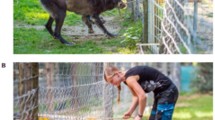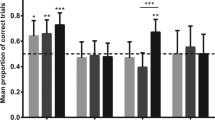Abstract
The aim of this work was to investigate the effect of dog breed groups, i.e., primitive, hunting/herding and Mastiff like (Study 1) and development, i.e., 4-month-old puppies vs adults (Study 2) on a quantity discrimination task. The task consisted of three conditions: C1—dogs were asked to choose between a large and a small amount of food; C2—the same choice was presented and dogs could choose after having witnessed the experimenter favouring the small quantity. C3—similar to C2 but the plates had two equally small food quantities. Study 1 revealed that dogs in the hunting/herding group were significantly more likely than Mastiff-like group to choose the small quantity indicated by the person over the large one, although all dog groups chose the large quantity over the small when they had a free choice. These results are consistent with the hypothesis that hunting/herding breeds have been selected for working in cooperation with humans and thus may be more sensitive to human social communicative cues than other breeds. In Study 2, results showed that 4-month-old puppies performed at chance level in C1, whereas in C2 both adults and puppies conformed to the experimenter’s choice. In C3, adults followed the experimenter significantly more than puppies, although puppies still followed the experimenter above chance. Overall, domestic dogs seem to rely heavily on social communicative cues from humans, even when the information contradicts their own perception. This tendency to respond to human social cues is present, although at a lesser extent already at 4 months.





Similar content being viewed by others
References
Abdai J, Gergely A, Petró E, Topál J, Miklósi Á (2015) An investigation on social representations: inanimate agent can mislead dogs (Canis familiaris) in a food choice task. PLoS One 10(8):e0134575
Agnetta B, Hare B, Tomasello M (2000) Cues to food locations that domestic dogs (Canis familiaris) of different ages do and do not use. Anim Cognit 3:107–112
Baker JM, Morath J, Rodzon KS, Jordan KE (2012) A shared system of representation governing quantity discrimination in canids. Front Psychol 3:387
Barrera G, Mustaca A, Bentosela M (2011) Communication between domestic dogs and humans: effects of shelter housing upon the gaze to the human. Anim Cognit 14(5):727–734
Bentosela M, Barrera G, Jakovcevic A, Elgier AM, Mustaca AE (2008) Effect of reinforcement, reinforcer omission and extinction on a communicative response in domestic dogs (Canis familiaris). Behav Process 78(3):464–469
Bisazza A, Piffer L, Serena G, Agrillo C (2010) Ontogeny of numerical abilities in fish. PLoS One 5(11):e15516
Bonanni R, Natoli E, Cafazzo S, Valsecchi P (2011) Free-ranging dogs assess the quantity of opponents in intergroup conflicts. Anim Cognit 14(1):103–115
Bräuer J, Kaminski J, Riedel J, Call J, Tomasello M (2006) Making inferences about the location of hidden food: social dog, causal ape. J Comp Psychol 120(1):38
Choudhury N, Gorman KS (2000) The relationship between sustained attention and cognitive performance in 17–24-month old toddlers. Inf Child Dev 9:127–146
Couillard NL, Woodward AL (1999) Children’s comprehension of deceptive points. Br J Dev Psychol 17:515–521
D’Aniello B, Scandurra A (2016) Ontogenetic effects on gazing behaviour: a case study of kennel dogs (Labrador Retrievers) in the impossible task paradigm. Anim Cognit 19:565–570
Danchin E, Giraldeau L-A, Valone TJ, Wagner RH (2004) Public information: from nosy neighbors to cultural evolution. Science 305:487–491
DeLong CM, Barbato S, O’Leary T, Wilcox KT (2017) Small and large number discrimination in goldfish (Carassius auratus) with extensive training. Behav Process 141:172–183
Dorey NR, Udell MA, Wynne CD (2010) When do domestic dogs, Canis familiaris, start to understand human pointing? The role of ontogeny in the development of interspecies communication. Anim Behav 79(1):37–41
Dwyer C, Cole MR (2018) Domesticated dogs (Canis familiaris) tend to follow repeated deceptive human cues even when food is visible. Learn Behav 46:442–448
Elgier AM, Jakovcevic A, Barrera G, Mustaca AE, Bentosela M (2009) Communication between domestic dogs (Canis familiaris) and humans: dogs are good learners. Behav Process 81:402–408
Feigenson L, Carey S, Hauser MD (2002) The representations underlying infants’ choice of more: object files versus analog magnitudes. Psychol Sci 13:150–156
Gàcsi M, McGreevy P, Kara E, Miklósi Á (2009) Effects of selection for cooperation and attention in dogs. Behav Brain Funct 5(1):31
Galef BG, Giraldeau LA (2001) Social influences on foraging in vertebrates: causal mechanisms and adaptive functions. Anim Behav 61:3–15
Hare B, Tomasello M (2005) Human-like social skills in dogs? Trends Cognit Sci 9:439–444
Hare B, Brown M, Williamson C, Tomasello M (2002) The domestication of social cognition in dogs. Science 298:1634–1636
Hauser MD, Spelke E (2004) Evolutionary and developmental foundations of human knowledge. Cog Neurosci 3:853–864
Horowitz A, Hecht G, Dedrick A (2013) Smelling more or less: investigating the olfactory experience of the domestic dog. Learn Motiv 44:207–217
Jakovcevic A, Elgier AM, Mustaca AE, Bentosela M (2010a) Breed differences in dogs’ (Canis familiaris) gaze to the human face. Behav Process 84(2):602–607
Jakovcevic A, Elgier AM, Mustaca AE, Bentosela M (2010b) Breed differences in dogs’ (Canis familiaris) gaze to the human face. Behav Process 84:602–607
Jaswal VK (2010) Believing what you’re told: young children’s trust in unexpected testimony about the physical world. Cognit Psychol 61:248–272
Jaswal VK, Pérez-Edgar K, Kondrad RL, Palmquist CM, Cole CA, Cole CE (2014) Can’t stop believing: inhibitory control and resistance to misleading testimony. Dev Sci 17(6):965–976
Kilian A, Yaman S, von Fersen L, Güntürkün O (2003) A bottlenose dolphin discriminates visual stimuli differing in numerosity. Anim Learn Behav 31:133–142
Konno A, Romero T, Inoue-Murayama M, Saito A, Hasegawa T (2016) Dog breed differences in visual communication with humans. PLoS One 11(10):e0164760
Kundey SMA, De Los Reyes A, Arbuthnot J, Allen R, Coshun A, Molina S, Royer E (2010) Domesticated dogs’ (Canis familiaris) response to dishonest human points. Int J Comp Psychol 23:201–215
Macpherson K, Roberts WA (2013) Can dogs count? Learn Motiv 44(4):241–251
Marshall-Pescini S, Passalacqua CA, Barnard S, Valsecchi P, Prato Previde E (2009) Agility and search and rescue training differently affects pet dogs’ behaviour in socio-cognitive tasks. Behav Process 81(3):416–422
Marshall-Pescini S, Prato-Previde E, Valsecchi P (2011) Are dogs (Canis familiaris) misled more by their owners than by strangers in a food choice task? Anim Cogn 14(1):137–142
Marshall-Pescini S, Passalacqua C, Miletto-Pedrazzini ME, Valsecchi P, Prato-Previde E (2012) Do dogs (Canis lupus familiaris) make counterproductive choices because they are sensitive to human ostensive cues? PLoS One 7(4):e35437
McKinley J, Sambrook TD (2000) Use of human-given cues by domestic dogs (Canis familiaris) and horses (Equus caballus). Anim Cognit 3(1):13–22
Miklósi A, Kubinyi E, Topaal J, Gaacsi M (2003) A simple reason for a big difference: wolves do not look back at humans, but dogs do. Curr Biol 13:763–766
Miletto-Petrazzini ME, Wynne CDL (2016) What counts for dogs (Canis lupus familiaris) in a quantity discrimination task? Behav Process 122:90–97
Miletto-Petrazzini ME, Wynne CDL (2017) Quantity discrimination in canids: dogs (Canis familiaris) and wolves (Cani lupus) compared. Behav Process 144:89–92
Parker HG, Kim LV, Sutter NB, Carlson S, Lorentzen TD, Malek TB, Johnson GS, DeFrance HB, Ostrander EA, Kruglyak L (2004) Genetic structure of the purebred domestic dog. Science 304:1160–1164
Passalacqua C, Marshall-Pescini S, Barnard S, Lakatos G, Valsecchi P, Prato-Previde E (2011) Human-directed gazing behaviour in puppies and adult dogs, Canis lupus familiaris. Anim Behav 82(5):1043–1050
Petter M, Musolino E, Roberts WA, Cole M (2009) Can dogs (Canis familiaris) detect human deception? Behav Process 82(2):109–118
Pisa PE, Agrillo C (2009) Quantity discrimination in felines: a preliminary investigation of the domestic cat (Felis silvestris catus). J Ethol 27(2):289–293
Plotnik JM, Lair R, Suphachoksahakun W, De Waal FB (2011) Elephants know when they need a helping trunk in a cooperative task. Proc Natl Acad Sci USA 108(12):5116–5121
Plude DJ, Enns JT, Brodeur D (1994) The development of selective attention: a life-span overview. Acta Psychol 86:227–272
Pongrácz P, Miyake T, Vida V, Csányi V (2005) The pet dogs ability for learning from a human demonstrator in a detour task is independent from the breed and age. Appl Anim Behav Sci 90:309–323
Prato-Previde E, Marshall-Pescini S, Valsecchi P (2008) Is your choice my choice? The owners’ effect on pet dogs’ (Canis lupus familiaris) performance in a food choice task. Anim Cognit 11:167–174
Renevey N, Bshary R, van de Waal E (2013) Philopatric vervet monkey females are the focus of social attention rather independently of rank. Behaviour 150(6):599–615
Riedel K, Schumann J, Kaminski Call J, Tomasello M (2008) The early ontogeny of human-dog communication. Anim Behav 75:1003–1014
Rieucau G, Giraldeau LA (2009) Persuasive companions can be wrong: the use of misleading social information in nutmeg mannikins. Behav Ecol 20(6):1217–1222
Rugani R, Fontanari L, Simoni E, Regolin L, Vallortigara G (2009) Arithmetic in newborn chicks. Proc R Soc Lond B Biol Sci 276(1666):2451–2460
Rugani R, Cavazzana A, Vallortigara G, Regolin L (2013) One, two, three, four, or is there something more? Numerical discrimination in day-old domestic chicks. Anim Cogn 16(4):557–564
Serpell JA, Duffy DL (2014) Dog breed and their behaviour. In: Horowitz A (ed) Domestic dog cognition and behavior. Springer, New York, pp 31–57
Szetei V, Miklósi Á, Topál J, Csányi V (2003) When dogs seem to lose their nose: an investigation on the use of visual and olfactory cues in communicative context between dog and owner. Appl Anim Behav Sci 83:141–152
Takaoka A, Maeda T, Hori Y, Fujita K (2015) Do dogs follow behavioral cues from an unreliable human? Anim Cognit 18(2):475–483
Turcsán B, Kubiny E, Miklósi A (2011) Trainability and boldness traits differ between breed clusters based on conventional breed categories and genetic relatedness. Appl Anim Behav Sci 132:61–70
Udell MA, Dorey NR, Wynne CD (2010) What did domestication do to dogs? A new account of dogs’ sensitivity to human actions. Biol Rev 85(2):327–345
Uller C, Lewis J (2009) Horses (Equus caballus) select the greater of two quantities in small numerical contrasts. Anim Cognit 12:733–738
Uller C, Jaeger R, Guidry G, Martin C (2003) Salamanders (Plethodon cinereus) go for more: rudiments of number in an amphibian. Anim Cognit 6:105–112
Ward C, Smuts BB (2007) Quantity-based judgments in the domestic dog (Canis lupus familiaris). Anim Cognit 10(1):71–80
West RE, Young RJ (2002) Do domestic dogs show any evidence of being able to count? Anim Cognit 5(3):183–186
Willis MB (1977) The German Shepherd dog: its history, development and genetics. Arco Publishing Company, New York, pp 19–32
Wobber V, Hare B, Koler-Matznick J, Wrangham R, Tomasello M (2009) Breed differences in domestic dogs’ (Canis familiaris) comprehension of human communicative signals. Interact Stud 10(2):206–224
Wynne CD, Udell MA, Lord KA (2008) Ontogeny’s impacts on human-dog communication. Anim Behav 76(4):e1–e4
Zaine I, Domeniconi C, Wynne CD (2015) The ontogeny of human point following in dogs: when younger dogs outperform older. Behav Process 119:76–85
Acknowledgements
This research was supported by doctoral grants from the University of Milan to CP and a doctoral grant from the University of Parma to SB. We are very grateful to Sarah Marshall-Pescini for her contribution in running the experiments and to all the owners and dogs who participated as volunteers in these studies.
Author information
Authors and Affiliations
Corresponding author
Ethics declarations
Conflict of interest
All authors declare that they have no conflicts of interest.
Ethical approval
All applicable international, national, and/or institutional guidelines for the care and use of animals were followed.
Additional information
Publisher's Note
Springer Nature remains neutral with regard to jurisdictional claims in published maps and institutional affiliations.
Rights and permissions
About this article
Cite this article
Barnard, S., Passalacqua, C., Pelosi, A. et al. Effects of breed group and development on dogs’ willingness to follow a human misleading advice. Anim Cogn 22, 757–768 (2019). https://doi.org/10.1007/s10071-019-01272-3
Received:
Revised:
Accepted:
Published:
Issue Date:
DOI: https://doi.org/10.1007/s10071-019-01272-3




